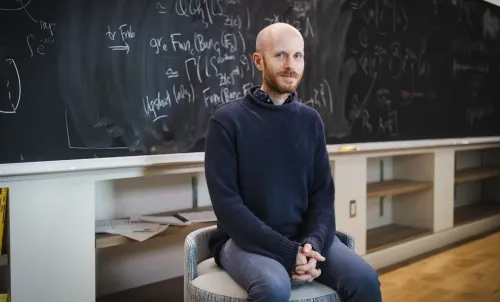Yale mathematician and six physicists win prestigious Breakthrough Prizes
Sam Raskin, James E. English Professor of Mathematics, was awarded a 2025 New Horizons in Mathematics prize from the Breakthrough Prize Foundation. Six Yale physicists were also honored for their work on international scientific experiments.

Sam Raskin, James E. English Professor of Mathematics, was among the winners of this year’s prestigious Breakthrough Prizes. Raskin was awarded a 2025 New Horizons in Mathematics prize for his work on the resolution of the geometric Langlands conjecture.
“Sam Raskin has played a significant role in the major recent progress on the geometric Langlands program,” wrote the Breakthrough Prize selection committee, “including the final proof of the geometric Langlands conjecture in characteristic 0.”
For their contributions to international scientific collaborations, six Yale physicists—Keith Baker, Helen Caines, Sarah Demers, John Harris, Laura Havener, and Paul Tipton—were among thousands of scientists awarded the Breakthrough Prize in Fundamental Physics. The award was given to recognize four international experimental collaborations at CERN’s Large Hadron Collider (LHC)—ATLAS, CMS, ALICE and LHCb—which are driven by collaboration from scientists from around the globe.
“By performing these extraordinarily precise and delicate tests,” wrote the selection committee, “the LHC experiments have pushed the boundaries of fundamental physics to unprecedented limits.”
“It's fantastic to see Sam honored for this outstanding mathematical achievement,” said Larry Gladney, FAS Dean of Science and Professor of Physics. “And to have six of our physicists honored for their collaborative work on groundbreaking, international experiments shows the impact and importance of their work.”
‘Centerpiece of mathematics’
Raskin worked with Dennis Gaitsgory of the Max Planck Institute and a team of seven other mathematicians to solve a segment of the Langlands Conjectures.
Langlands's conjectures have been considered a centerpiece of mathematics since they were posited by former Yale professor Robert Langlands in the 1960s, who suggested that there were undiscovered connections between number theory and harmonic analysis. Raskin's work on the geometric Langlands program proved a related conjecture in geometry.
Proving those connections allows mathematicians and other interested scientists to translate between seemingly dissimilar fields of math. Geometric Langlands has meaning in theoretical particle physics, where it manifests as surprising relationships between the theories of different particles.
“Modern physics and higher mathematics share intimate connections, and it is notable that the research areas of all three of this year’s New Horizons in Mathematics Prize winners have links to quantum physics,” wrote the Breakthrough Prize selection committee.
“I am greatly honored to have received the New Horizons prize,” said Raskin. “It recognizes work that was completed with the help of gifted collaborators and friends. I am grateful for the recognition our work has received.”
Global physics collaborations
The Breakthrough Prize in Fundamental Physics was awarded to thousands of researchers from more than 70 countries representing four experimental collaborations at CERN’s Large Hadron Collider: ATLAS, CMS, ALICE and LHCb.
Six Yale physicists—alongside their teams of postdoctoral researchers and graduate students—were included in the honors:
- Keith Baker, D. Allan Bromley Professor of Physics
- Helen Caines, Horace D. Taft Professor of Physics
- Sarah Demers, Professor of Physics
- John Harris, D. Allan Bromley Professor Emeritus of Physics
- Laura Havener, Assistant Professor of Physics
- Paul Tipton, Eugene Higgins Professor of Physics
“The four experiments are recognized for testing the modern theory of particle physics—the Standard Model—and other theories describing physics that might lie beyond it to high precision,” wrote the Breakthrough Prize selection committee.
These experiments have seen physicists precisely measure properties of the Higgs boson particle; probe rare particle interactions and states of matter that “existed in the first moments of the Universe;” discover more than 72 new hadrons; measure differences between particles of matter and antimatter; and set “strong bounds on possibilities for new physics beyond the Standard Model, including dark matter, supersymmetry and hidden extra dimensions.”
The $3 million prize was allocated to the four experiments—ATLAS ($1 million); CMS ($1 million), ALICE ($500,000) and LHCb ($500,000)—to recognize 13,508 “co-authors of publications based on LHC Run-2 data released between 2015 and July 15, 2024.”
In consultation with the Breakthrough Prize Foundation, all four experiments elected to donate 100% of their prize money to the CERN & Society Foundation, which will use the money to fund grants for doctoral students from member institutes to "spend research time at CERN, giving the students experience working at the forefront of science and new expertise to bring back to their home countries and regions."